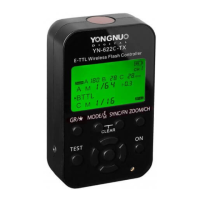The Other YN-622C User Guide v.4.09
11/12/2014
Part II – 622C Transceivers Page 54 of 64
Two-Shooter setup
A second shooter can share the augmenting flashes. But, there is a problem – preventing the
zooming and firing of the other camera’s on-TX flash.
622C Transmitter With C-TX Controller
Both Cameras
• 622C as transmitter set to REMOTE
mode and receiving group C.
• Camera set to E-TTL mode, firing group
A:B and a ratio/output.
• On-top Flash set by camera to E-TTL.
Both Cameras
• 622C as transmitter set to MIX mode
and receiving group C.
• Camera set to firing group A:B. Mix
mode forces the camera to E-TTL.
• On-top Flash set on-flash to E-TTL.
Augmenting Flashes
• Remote 622Cs set to receiving group B.
• Flashes will be set remotely to E-TTL or
a Manual output.
Augmenting Flashes
• Remote 622Cs set to receiving group A
and/or B.
• Flashes will be set remotely to a Manual
output..
C-TX Controller, hand-held.
• Set group A to a Manual output, group B
to Manual output and group C to E-TTL.
When either camera takes a shot, its own on-TX
flash is treated as group A and fires. The
augmenting flashes are treated as group B. The
other camera’s flash is treated as group C. As
group C is not enabled in firing group A:B, it
does not fire.
This configuration provides for two shooters,
and one or two remotely-controlled groups for
augmenting flashes.
Class 5 Studio flashes with Cybersync Commander (DM Ward
technique)
Mixed Speedlites and remote-controlled studio flashes
The Cybersync provides easy remote control of studio flashes for adjusting power, and the 622C
provides triggering of the studio flashes and full control of any 622C-mounted hot-shoe flashes.
622C Transmitter C-TX Controller
• Camera + 622C + YN568EX. • Camera + C-TX + flash bracket
+ 622C + YN568EX
• Place a 622C nearby (neck cord or pocket) and mount a Cybersync Commander on it.
• Mount studio flashes, e.g. Einsteins, on stands for augmented ambient or rim light. Connect
a Cybersync receiver to each.

